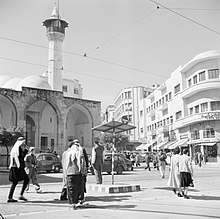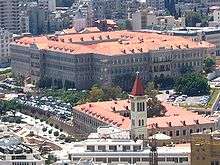Timeline of Beirut
Prior to 20th century
- 140 BC – City destroyed by Diodotus Tryphon.[1]
- 64 BC – Beirut conquered by Agrippa.
- 14 BC – During the reign of Herod the Great, Berytus became a colonia.
- 551 CE – Earthquake.[1]
- 635 – Beirut passes into Arab control.[1]
- 759 – Prince Arslan bin al-Mundhir founds the Principality of Sin-el-Fil in Beirut.
- 1110 – Baldwin overtakes city, is absorbed into the Kingdom of Jerusalem.[1]
- 1187 – Saladin overtakes city.[1]
- 1763 – Ottomans reclaim the city.[1]
- 1832 – Ibrahim Pasha of Egypt in power.[2]
- 1840 – October: Battle of Beirut.[2]
- 1853 – Grand Serail built.
- 1858 – Government Hadiqat al-Akhbar newspaper begins publication.
- 1860
- Druze–Maronite conflict.
- Sursock House built.
- 1866 – Syrian Protestant College established.
- 1868 – Archaeological Museum of the American University of Beirut established.
- 1875
- Saint Joseph University founded.
- Thamarāt al-funūn newspaper begins publication.[3]
- 1877 – Lisan al-Hal newspaper begins publication.[3]
- 1883 – Hôtel-Dieu de France founded.
- 1888 – Beirut was made capital of a vilayet (governorate) in Syria,[37] including the sanjaks (prefectures) Latakia, Tripoli, Beirut, Acre and Bekaa.
- 1894 – Saint George Maronite Cathedral and Harbor constructed.[1]
- 1895 – Railway completed "across the Lebanon to Damascus."[1]
- 1898 – Population: 120,000 (approximate).[4]
20th century
1900s–1960s
- 1902 – al-Iqbāl newspaper begins publication.[3]
- 1907
- Railway to Aleppo completed.[1]
- René Moawad Garden established.
- Baidaphon (record label) in business (approximate date).[5]
- 1916 – Place des Canons renamed Martyrs' Square.
- 1920 – Beirut Stock Exchange founded.
- 1920 – 1 September: Lebanon Republic (Greater Lebanon) proclaimed a state.
- 1921 – Beirut Traders Association founded.[6]
- 1924 – Al Joumhouria newspaper begins publication.
- 1925
- National Conservatory of Music established.[5]
- Maghen Abraham Synagogue built.
- 1927 – American Junior College for Women opens in Ras Beirut.
- 1933
- Parliament of Lebanon building erected.
- An-Nahar newspaper begins publication.[3]
- L'Orient newspaper begins publication.
- 1934 – Population: 162,000 (approximate).[7]
- 1936 – Kamel Abbas Hamieh takes office as Governor of Beirut.
- 1937
- 1938 – Al Akhbar newspaper begins publication.
- 1941 – Eastern Times newspaper begins publication.[3]
- 1942 – National Museum of Beirut opens.
 View of Beirut in 1950
View of Beirut in 1950 - 1943 – Beirut becomes capital city of independent Lebanon.
- 1946
- Nicolas Rizk takes office as Governor of Beirut.
- Al-Hayat newspaper begins publication.
- 1950 – Population: 181,271.[8]
 Beirut in 1950
Beirut in 1950 - 1951 – Lebanese University and Lycée Franco-Libanais Verdun founded.
- 1952
- George Assi takes office as Governor of Beirut.
- The Daily Star newspaper begins publication.
- 1954 – Beirut Rafic Hariri International Airport opens.
- 1956 – Bachour Haddad takes office as Governor of Beirut.
- 1957 – Camille Chamoun Sports City Stadium opens.
- 1958 – Population: 400,000 (estimate).[9]
- 1959
- Télé Liban (television) begins broadcasting.[10]
- Philip Boulos takes office as Governor of Beirut.
- Al Anwar newspaper begins publication.
- 1960
- Beirut Arab University established.
- Emile Yanni takes office as Governor of Beirut.
- 1961
- Orient-Institut Beirut established.
- Sursock Museum and Phoenicia Beirut Hotel open.
- 1963 – Gallery One (cultural space) opens.[11]
- 1964 – Saint Nicolas Garden opens.
- 1966 – Al Ahed football team established, headquartered in Beirut.
- 1967 – Chafik Abou Haydar takes office as Governor of Beirut.
- 1968 – "Israel raids Beirut airport."[12]
1970s–1990s
- 1970
- L'Orient Le Jour newspaper begins publication.
- Population: 474,870 city; 938,940 urban agglomeration.[13]
- 1972 – Manoukian Center established.[11]
- 1973 – Holiday Inn in business.[14]
- 1974 – As-Safir newspaper begins publication.
- 1975
- April: Lebanese Civil War begins.[12]
- Green Line established between mainly Muslim factions in West Beirut and the Christian Lebanese Front in East Beirut.
- Centre for Arab Unity Studies founded.[15]
- 1976 – al-Murābiṭ newspaper begins publication.[3]
- 1977 – Mitri El Nammar takes office as Governor of Beirut.
- 1978 – Syrian siege of Achrafiyeh, the main Christian district of Beirut.
- 1982
- Israeli invasion.
- 14 September: Bachir Gemayel assassinated.
- 1983 – French and US barracks bombed.
- 1986 – Centre de Documentation et de Recherches Arabes Chretiennes founded.[16]
- 1987 – George Smaha takes office as Governor of Beirut.
- 1988 – Ad-Diyar newspaper begins publication.
- 1989 – Lebanese Center for Policy Studies headquartered in city.[15]
- 1990 – Solidere (redevelopment company) and Center for Strategic Studies Research and Documentation[15] founded.
- 1991 – Al Manar TV begins broadcasting.
- 1992 – Nayef Al Maaloof takes office as Governor of Beirut
- 1993
- B 018 nightclub opens.
- Future Television begins broadcasting.
- 1994 – Souk el-Tayeb farmer's market opens.[17]
- 1995 – Nicolas Saba takes office as Governor of Beirut
- 1997
- Arab Image Foundation established.[18]
- Camille Chamoun Sports City Stadium rebuilt.
- 1999
- Yaacoub Sarraf takes office as Governor of Beirut.
- Planet Discovery children's museum inaugurated.
- Lebanese National Symphony Orchestra and Al-Kafaàt University founded.
- 2000 – Museum of Lebanese Prehistory established.
21st century
2000s
- 2001 – Beirut International Exhibition & Leisure Center opens.
- 2003
- Beirut Marathon begins.
- Music Hall opens.
- Al-Balad newspaper begins publication.
- 2004
- 2005
- Cedar Revolution
- Nassif Kaloosh takes office as Governor of Beirut
- Ya Libnan news website launched.
- 2006
- Political protests
- Robert Mouawad Private Museum opens.
- Sister city relationship established with Los Angeles, USA.[22]
- 2007 – Mohammad Al-Amin Mosque built.
- 2008 – Platinum Tower built.
- 2009
- 2009 Jeux de la Francophonie held in Beirut.
- Beirut Art Center opens.[18]
- Beirut Souks and Le Gray hotel in business.[17]
- City named World Book Capital by UNESCO.
2010s
- 2010
- Bilal Hamad becomes mayor.
- Four Seasons Hotel Beirut opens.[23]
- 2011
- Political protests
- Zaitunay Bay pedestrian area opens.[24]
- 2012
- Violent unrest related to Syrian uprising.
- Al-Mayadeen television begins broadcasting.[25]
- 19 October: Bombing in Achrafieh.
- 16 November: Überhaus nightclub opens.
- 2013
- 2015
- 21 July: Protests.
- 12 November: Bombing.
2020s
- 2020
- 4 August: Explosions.
gollark: But what if you remember your password but bees take it and your password manager lacks an option for it? WHAT THEN?
gollark: Yes, I use a password manager, but options like "I am actively unable to remember anything" would really add to password-using systems.
gollark: I really want other stuff to have those forgot password options now?
gollark: https://cdn.discordapp.com/attachments/348702212110680064/743987614062870668/unknown.png
gollark: In which case, the implications should be considered seriously if they're actually the case.
References
- Britannica 1910.
- Haydn 1910.
- OCLC. "WorldCat". Retrieved 11 June 2012.
- Palestine and Syria, Karl Baedeker, Leipzig, 1898
- Racy 1986.
- "Beirut Traders Association". Retrieved 14 June 2012.
- Mittelmeer, Karl Baedeker, Leipzig, 1934
- The Columbia Encyclopedia, CUP, New York, 1950
- "Population of capital cities and cities of 100,000 and more inhabitants". Demographic Yearbook 1965. New York: Statistical Office of the United Nations. 1966. pp. 140–161.
- Europa World Year Book 2004. Europa Publications. ISBN 978-1-85743-255-8.
- Rogers 2008.
- "Chronology of Key Events". Lebanon Profile. BBC News. Retrieved 11 June 2012.
- United Nations Department of Economic and Social Affairs, Statistical Office (1987). "Population of capital cities and cities of 100,000 and more inhabitants". 1985 Demographic Yearbook. New York. pp. 247–289.
- "A history of cities in 50 buildings", The Guardian, UK, 2015
- "Think Tank Directory". Philadelphia: Foreign Policy Research Institute. Archived from the original on 10 November 2013. Retrieved 19 November 2013.
- Scalenghe 2003.
- M. Egan (28 March 2010). "The Scene- Beirut". New York Times.
- "Lebanon". Art Spaces Directory. New York: New Museum. Retrieved 19 November 2013.
- Deeb 2007.
- Mona Khechen (2007). "Beyond the Spectacle: Al-Saha Village, Beirut". Traditional Dwellings and Settlements Review. International Association for the Study of Traditional Environments. 19 – via University of California, Berkeley.

- Deeb 2013.
- "Sister Cities of Los Angeles". USA: City of Los Angeles. Retrieved 30 December 2015.
- S. Sherwood (29 April 2010). "36 Hours in Beirut". New York Times.
- R. Doyle (17 February 2012). "In Beirut, the Zaitunay Bay Promenade Opens". New York Times.
- "New pan-Arab satellite channel hopes to counter Al-Jazeera's Arab Spring coverage". Washington Post. Associated Press. 11 June 2012.
This article incorporates information from the French Wikipedia.
Bibliography
- Published in 19th century
- John Macgregor (1844). "Syria and Palestine: Beyrout". Commercial Statistics. London: C. Knight and Co.
- "Beyrout", Cook's Tourists' Handbook for Palestine and Syria, London: T. Cook & Son, 1876
- Èmile Isambert (1881). "Beyrout". Itinéraire descriptif, historique et archéologique de l'Orient. Guides Joanne (in French). 3: Syrie, Palestine.
- R. Lambert Playfair (1892), "Beyrout", Handbook to the Mediterranean (3rd ed.), London: John Murray
- "Beirut", Handbook for Travellers in Syria and Palestine (3rd ed.), Leipsig: K. Baedeker, 1898
- Published in 20th century
- "Beirut", Encyclopædia Britannica (11th ed.), New York, 1910, OCLC 14782424 – via Internet Archive
- Benjamin Vincent (1910). "Beyrout". Haydn's Dictionary of Dates (25th ed.). London: Ward, Lock & Co.
- Ali Jihad Racy (1986). "Words and Music in Beirut: A Study of Attitudes". Ethnomusicology. 30 (3): 413–427. doi:10.2307/851587. JSTOR 851587.
- Mona Takieddin Amyuni (1987). "The Image of the City: Wounded Beirut". Alif: Journal of Comparative Poetics (7). JSTOR 521854. — literary criticism
- Dona J. Stewart (1996). "Economic Recovery and Reconstruction in Postwar Beirut". Geographical Review. 86 (4): 487–504. doi:10.2307/215929. JSTOR 215929.
- Saree Makdisi (1997). "Laying Claim to Beirut: Urban Narrative and Spatial Identity in the Age of Solidere". Critical Inquiry. 23 (3): 661–705. doi:10.1086/448848. JSTOR 1344040.
- Projecting Beirut. 1998.
- Published in 21st century
- Sara Scalenghe and Nadya Sbaiti (2003). "Conducting Research in Lebanon: An Overview of Historical Sources in Beirut". Middle East Studies Association Bulletin. 37. JSTOR 23063088.
- C. Edmund Bosworth, ed. (2007). "Beirut". Historic Cities of the Islamic World. Leiden: Koninklijke Brill. p. 53+. ISBN 978-9004153882.
- Lara Deeb and Mona Harb (2007). "Sanctioned Pleasures: Youth, Piety and Leisure in Beirut". Middle East Report (245): 12–19. JSTOR 25164816.
- Michael R.T. Dumper; Bruce E. Stanley, eds. (2008), "Beirut", Cities of the Middle East and North Africa, Santa Barbara, USA: ABC-CLIO, p. 82+, ISBN 9781576079201
- Joe Nasr; Eric Verdeil (2008). "Reconstructions of Beirut". City in the Islamic World. Leiden: Koninklijke Brill. p. 1115+. ISBN 978-9004171688 – via HAL, Centre pour la communication scientifique directe, France.
- Sarah Rogers (2008). "Producing the Local: The Visual Arts in Beirut". Middle East Studies Association Bulletin. 42 (1/2): 19–25. JSTOR 23063538.
- Gerhard Böwering, ed. (2013). "Beirut". Princeton Encyclopedia of Islamic Political Thought. Princeton University Press. p. 67. ISBN 978-0-691-13484-0.
- Lara Deeb; Mona Harb (2013). Leisurely Islam: Negotiating Geography and Morality in Shi'ite South Beirut. Princeton University Press. ISBN 978-1-4008-4856-0.
External links
| Wikimedia Commons has media related to History of Beirut. |
- Fulltext articles related to Beirut (via HAL, Centre pour la communication scientifique directe, France)
- ArchNet. "Beirut". Archived from the original on 23 October 2012.
This article is issued from Wikipedia. The text is licensed under Creative Commons - Attribution - Sharealike. Additional terms may apply for the media files.
